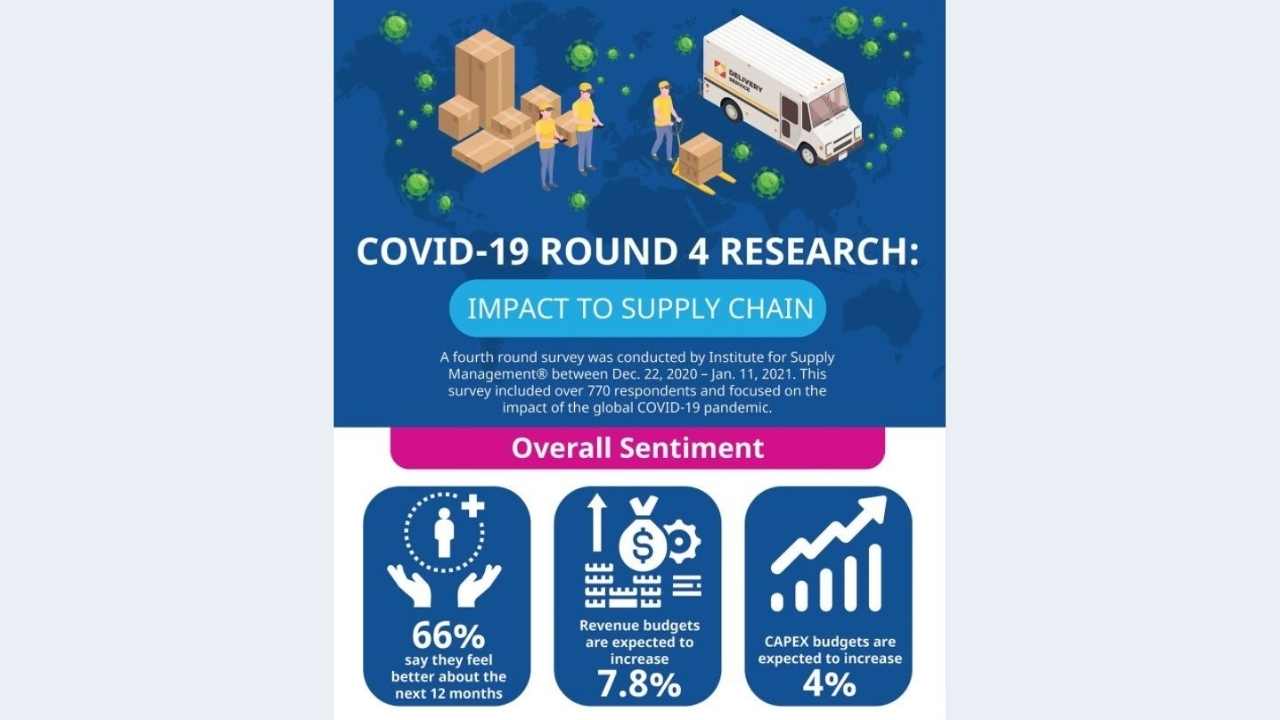
Institute for Supply Management® examines virus' effects with a fourth round of research
The majority of respondents (64%) feel business will be better during the second half of 2021 compared to the first half of the year, and 66% report their organization feels better about business overall over the next 12 months.
Revenue budgets are reported to increase by 7.8% and CAPEX budgets are also reported to increase this year by 4%. Survey results note that demand for products and/or services is forecasted to increase 10% in 2021 compared to 2020 actuals.
For 2021, respondents most often mention concern about risk to suppliers, shipment delays and remote work issues. Thirty percent report concern over increased risk to Tier-1 suppliers, more than half (56%) are concerned over delays in shipment and supply, 31% report a concern over managing remote work, and 21% report needing to invest more in remote work infrastructure.
"Around the globe, even with concerns around supplier risk, shipping delays and work from home challenges, companies are continuing to adapt to the changing environment created by the COVID-19 pandemic and feel bullish, particularly about the second half of 2021," said Thomas W. Derry, chief executive officer of ISM. "There is a strong positive sentiment that business activity will be substantially better than in 2020, and revenue, CAPEX and demand for products are all expected to increase this year. That said, supply constraints – notably in shipping and freight, scarcity of many raw materials and components, and a widely reported inability to hire qualified labor – are limiting the ability of some firms to take maximum advantage of the surge in aggregate demand."
In July 2020, many regions reported an increase in severe supply chain disruptions, however, only 36% of respondents reported severe disruptions in China, a small improvement over what was reported in April 2020 research (38%). By the middle of January 2021, severe disruptions improved in all regions. In North America, severe supply chain disruptions were reported at 10% of respondents for the U.S, 8% of respondents for Mexico, and 7% of respondents for Canada. Outside of North America, severe supply chain disruptions were reported at 28% of respondents for China, 15% of respondents for Europe, 10% of respondents for Japan, and 9% of respondents for Korea.
"Compared to Round 2 and Round 3 of ISM's research, practitioners are more optimistic about the impact of the pandemic on 2021, and the easing up of severe supply chain disruptions is one indication of that sentiment," said Derry.
Global and domestic U.S. organizations are reporting the following primary supply chain impacts, as the virus' impacts continue.
Lead Times
● Average lead times for delayed inputs have improved in most regions compared to the end of July 2020 and are less than twice as long as compared to "normal" operations, for Europe (193%), Japan (190%), Korea (189%), and domestically sourced inputs (177%). China is still at or above twice as long as "normal" lead times (202%).
● Compared to the end of 2020, 64% of respondents report that lead times for inputs from China have pushed out. Sixty-eight percent report longer lead times for European inputs and between 40-54% report lengthening lead times for inputs sourced from North American countries.
● During the fourth quarter of 2021, only 11% of respondents expect longer lead times for U.S. inputs, eight percent of respondents expect longer lead times from Canadian suppliers and 10% expect longer lead times from Mexico. Europe is expected to be the most impacted, with 20% of respondents expecting longer lead times for European inputs.
Manufacturing Capacity
● Domestic manufacturing is operating at 87% of normal capacity. Chinese manufacturing is at 86% and European manufacturing is at 76% of normal capacity.
Inventory
● With increasing confidence overall, 93% of firms report that they expect to have sufficient inventory on hand at North American facilities in fourth quarter 2021 to support operations. For Canadian operations, that proportion is 91% and for Mexico, 87%.
● For other regions, confidence that sufficient inventory will be on hand for operations in fourth quarter 2021 is also high: the Middle East (96%), Japan (91%), Europe (89%), Korea (88%), China (85%), and India (81%).
● Eighty-two percent of respondents say their firms' input inventories have been adjusted and 56% are holding more than usual inventory, either intentionally or unintentionally.
Headcount
● During the second quarter of 2021, 27% of respondents report that their organizations will likely delay hiring, nine percent will reduce hours, and 14% will reduce headcount. Additionally, 25% anticipate increasing headcount and 40% anticipate no adjustment.
● Staffing levels increased for North American respondents (U.S. 88%; Mexico 85%; Canada 87%). Europe (84%) and Japan (86%) also saw increases, with China (88%) and Korea (83%) remaining the same as the end of July 2020. India reported staffing levels at 79% and the Middle East at 75% of normal levels.
The survey's 779 respondents largely represent U.S. manufacturing (56%) and non-manufacturing (44%) organizations. Miscellaneous Manufacturing (9%); Transportation Equipment (7%); Fabricated Metal Products (6%); Electrical Equipment, Appliances & Components (6%); and Machinery (6%) were the top manufacturing sub-sectors. Health Care & Social Assistance (7%) was the top non-manufacturing sector represented by respondents.
Eighty-six percent of the respondents come from organizations with annual revenues of less than US$10 billion. Respondent roles range from emerging practitioner (2%), to chief procurement officer (7%), with 78 percent being experienced practitioners, managers, directors and vice presidents in a supply chain management role.
NEWSLETTER
TRENDING ON PRO MFG
MORE FROM THE SECTION









